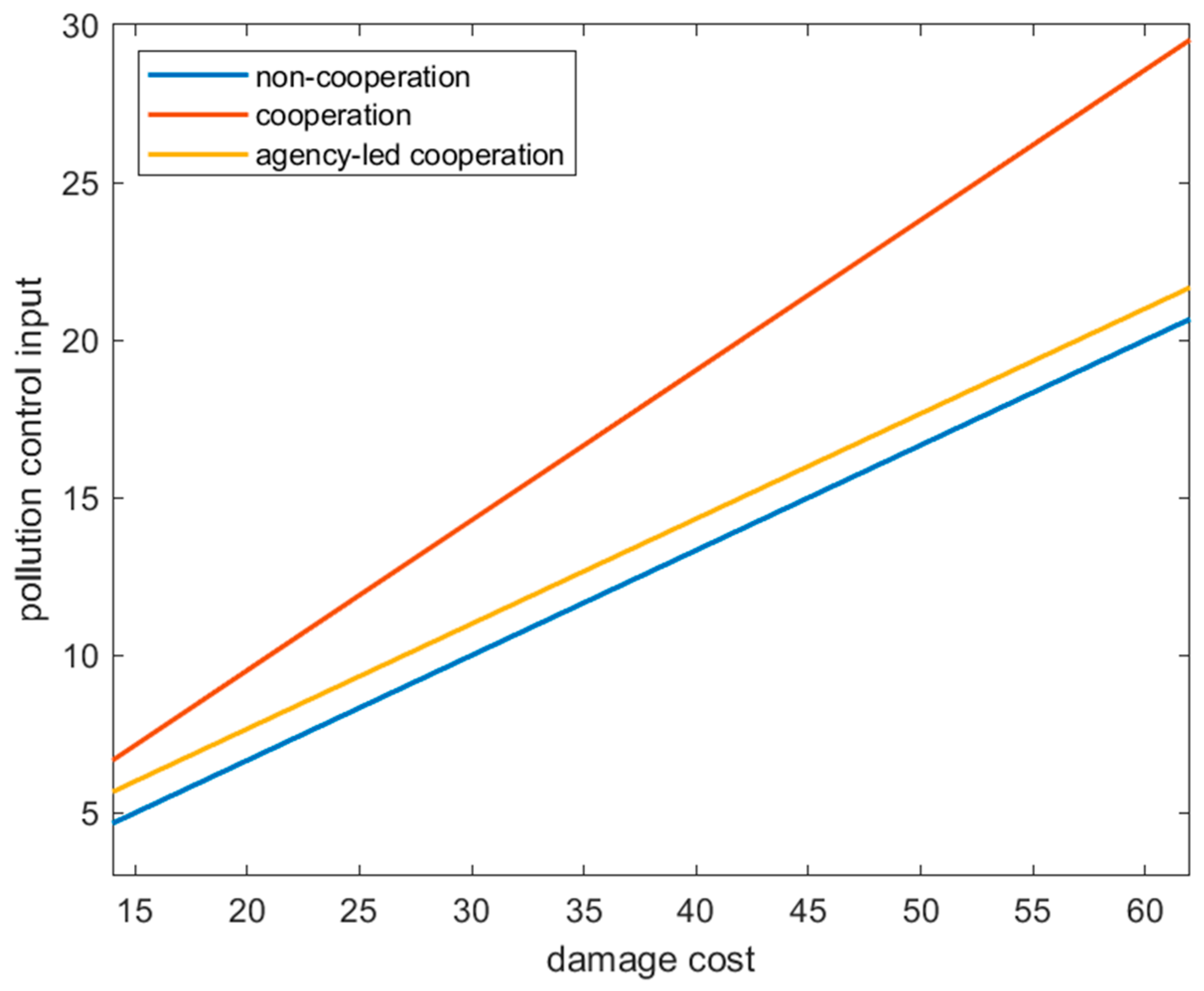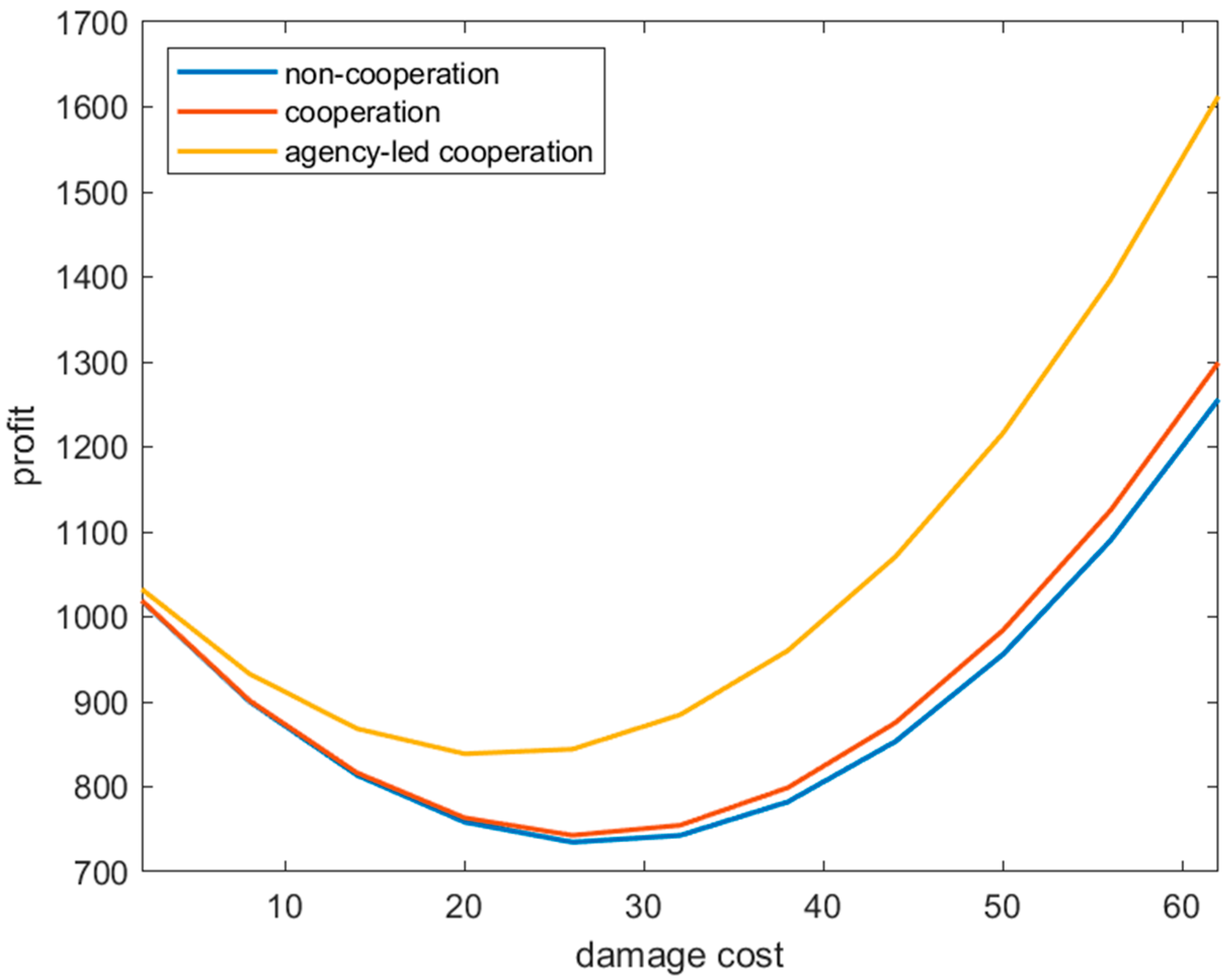Research on Strategies for Controlling Cross-Border Water Pollution under Different Management Scenarios
Abstract
1. Introduction
2. Model Notation and Basic Assumptions
3. Model Modeling and Solution Analysis
3.1. Non-Cooperation Scenario
3.2. Cooperation Scenario
3.3. Basin Agency-Led Cooperation Scenario
4. Comparative and Simulation Analyses
4.1. Comparative Analysis
- (i)
- (ii)
- 1.
- In cases where upstream areas are actually discharging water pollution, the basin agency-led cooperation scenario demonstrates remarkable advantages. It not only effectively reduces the discharge volume from upstream, but also prompts the highest level of water pollution control inputs, thereby maximizing the total profit for both upstream and downstream. This indicates that the cooperation model led by river basin entities possesses greater efficiency and effectiveness in addressing water pollution issues.
- 2.
- Regardless of whether there is water pollution discharge from upstream, the cooperation scenarios consistently exhibit higher levels of treatment investment and better overall benefits. Notably, even when upstream areas are not actually discharging pollutants, the cooperation scenario, though resulting in slightly higher discharge volumes compared to the basin agency-led cooperation scenario, also invests more in water pollution treatment. At this point, the total benefits remain on par and optimal, underscoring the vital role of cooperation mechanisms in water resource protection. This also suggests that downstream governments are willing to share the cost of upstream governments’ water pollution control inputs, as they are aware of the benefits that upstream governments’ water pollution control can bring to them.
- 3.
- In the non-cooperative scenario, emissions, treatment investments, and total revenues are all the worst. This reaffirms the significance of cooperation and coordination in addressing cross-regional water pollution problems.
4.2. Simulation Analysis
5. Conclusions and Implications
5.1. Conclusions
- (1)
- The balanced results comparing the three management scenarios indicate that, when the upstream region actually discharges water pollution, the scenario led by the river basin authority results in the lowest upstream emissions, the highest investment in water pollution treatment, and the highest total benefit for both upstream and downstream regions. Therefore, the cooperation strategy under the leadership of the river basin authority is optimal.
- (2)
- Improving abatement efficiency helps increase water pollution control inputs and total basin revenues. This highlights the importance of basin governance mechanisms and emphasizes the key role of synergies and basin management in addressing water pollution.
- (3)
- As damage costs increased, water pollution control inputs increased in all scenarios, with the highest total revenues in the basin agency-led cooperation scenario, followed by the cooperation scenario and the lowest in the non-cooperation scenario.
5.2. Implication
- (1)
- The governments of upstream and downstream regions should actively promote the establishment and development of cross-border cooperation mechanisms to facilitate the coordination and integration of water pollution management inputs. Basin-based cooperation platforms or institutions should be established to promote the joint participation of all parties in water pollution management and the sharing of costs and benefits.
- (2)
- Through cooperation, all parties can optimize the allocation of resources and improve the efficiency of water pollution control inputs. The government and enterprises should rationalize the allocation of resources according to the actual situation and focus on supporting the research and development and application of water pollution control technologies to improve the effectiveness of water pollution control.
- (3)
- Recognize the importance of the cost of environmental damage to enterprises and society, and take measures to strengthen environmental monitoring and assessment, establish an environmental protection fund and promote green technological innovation, thereby reducing the social cost of water pollution control and realizing a win-win situation in terms of both economic and social benefits.
Author Contributions
Funding
Institutional Review Board Statement
Informed Consent Statement
Data Availability Statement
Conflicts of Interest
Appendix A
Appendix B
Appendix C
Appendix D
References
- Li, M.X.; Zou, S.R.; Jing, P.R. Spatial Spillover Effect of Water Environment Pollution Control in Basins-Based on Environmental Regulations. Water 2023, 15, 3745. [Google Scholar] [CrossRef]
- Ma, T.; Sun, S.; Fu, G.T.; Hall, J.W.; Ni, Y.; He, L.H.; Yi, J.W.; Zhao, N.; Du, Y.Y.; Pei, T.; et al. Pollution exacerbates China’s water scarcity and its regional inequality. Nat. Commun. 2020, 11, 650. [Google Scholar] [CrossRef]
- Fletcher, R.; Büscher, B. The PES Conceit: Revisiting the Relationship between Payments for Environmental Services and Neoliberal Conservation. Ecol. Econ. 2017, 132, 224–231. [Google Scholar] [CrossRef]
- Wine, M.L. Under non-stationarity securitization contributes to uncertainty and Tragedy of the Commons. J. Hydrol. 2019, 568, 716–721. [Google Scholar] [CrossRef]
- Sigman, H. Transboundary spillovers and decentralization of environmental policies. J. Environ. Econ. Manag. 2005, 50, 82–101. [Google Scholar] [CrossRef]
- Zeng, Y.; Li, J.B.; Cai, Y.P.; Tan, Q.; Dai, C. A hybrid game theory and mathematical programming model for solving trans-boundary water conflicts. J. Hydrol. 2019, 570, 666–681. [Google Scholar] [CrossRef]
- Yi, Y.X.; Ding, C.N.; Fu, C.Y.; Li, Y.Q. Transboundary watershed pollution control and product market competition with ecological compensation and emission tax: A dynamic analysis. Environ. Sci. Pollut. Res. 2022, 29, 41037–41052. [Google Scholar] [CrossRef]
- Huang, X.F.; Hua, W.W.; Dai, X.Y. Performance Evaluation of Watershed Environment Governance—A Case Study of Taihu Basin. Water 2022, 14, 158. [Google Scholar] [CrossRef]
- Chen, K.; Deng, M.H.; Fan, S.S. Synergetic development assessment of transboundary watershed ecological compensation. Water Sci. Technol. 2023, 88, 1438–1446. [Google Scholar] [CrossRef]
- Lu, H.W.; Yu, S. Pollutant source analysis and tempo-spatial analysis of pollutant discharge intensity in a transboundary river basin. Environ. Sci. Pollut. Res. 2019, 26, 1336–1354. [Google Scholar] [CrossRef]
- El Ouardighi, F.; Sim, J.E.; Kim, B. Pollution accumulation and abatement policy in a supply chain. Eur. J. Oper. Res. 2016, 248, 982–996. [Google Scholar] [CrossRef]
- Guo, G.M.; Duan, R.B. A new method to determine the scale range of environmental damage caused by water pollution accidents. Water Supply 2022, 22, 3968–3979. [Google Scholar] [CrossRef]
- Jing, S.W.; Liao, L.P.; Du, M.Z.; Shi, E.Y. Assessing the effect of the joint governance of transboundary pollution on water quality: Evidence from China. Front. Environ. Sci. 2022, 10, 989106. [Google Scholar] [CrossRef]
- Jiang, K.; Merrill, R.; You, D.M.; Pan, P.; Li, Z.D. Optimal control for transboundary pollution under ecological compensation: A stochastic differential game approach. J. Clean. Prod. 2019, 241, 118391. [Google Scholar] [CrossRef]
- Benchekroun, H.; Martín-Herrán, G. The impact of foresight in a transboundary pollution game. Eur. J. Oper. Res. 2016, 251, 300–309. [Google Scholar] [CrossRef]
- Bellver-Domingo, A.; Hernández-Sancho, F.; Molinos-Senante, M. A review of Payment for Ecosystem Services for the economic internalization of environmental externalities: A water perspective. Geoforum 2016, 70, 115–118. [Google Scholar] [CrossRef]
- Jiang, K.; You, D. Study on differential game of transboundary pollution control under regional ecological compensation. China Popul. Resour. Environ. 2019, 29, 135–143. [Google Scholar]
- Hao, C.L.; Yan, D.H.; Gedefaw, M.; Qin, T.L.; Wang, H.; Yu, Z.L. Accounting of Transboundary Ecocompensation Standards Based on Water Quantity Allocation and Water Quality Control Targets. Water Resour. Manag. 2021, 35, 1731–1756. [Google Scholar] [CrossRef]
- Li, S.D. A Differential Game of Transboundary Industrial Pollution with Emission Permits Trading. J. Optim. Theory Appl. 2014, 163, 642–659. [Google Scholar] [CrossRef]
- Li, S.D. Dynamic optimal control of pollution abatement investment under emission permits. Oper. Res. Lett. 2016, 44, 348–353. [Google Scholar] [CrossRef]
- Huang, X. Transboundary watershed pollution control analysis for pollution abatement and ecological compensation. Environ. Sci. Pollut. Res. 2023, 30, 44025–44042. [Google Scholar] [CrossRef]
- Chang, S.H.; Qin, W.H.; Wang, X.Y. Dynamic optimal strategies in transboundary pollution game under learning by doing. Phys. A-Stat. Mech. Its Appl. 2018, 490, 139–147. [Google Scholar] [CrossRef]
- Zhao, L.J.; Qian, Y.; Huang, R.B.; Li, C.M.; Xue, J.; Hu, Y. Model of transfer tax on transboundary water pollution in China’s river basin. Oper. Res. Lett. 2012, 40, 218–222. [Google Scholar] [CrossRef]
- Song, J.X.; Wu, D.S. An innovative transboundary pollution control model using water credit. Comput. Ind. Eng. 2022, 171, 108235. [Google Scholar] [CrossRef]
- Sheng, J.C.A.; Webber, M. Incentive coordination for transboundary water pollution control: The case of the middle route of China’s South-North water Transfer Project. J. Hydrol. 2021, 598, 125705. [Google Scholar] [CrossRef]
- Kolaolusanya, A.; Oyeyemi, E.; Adewale, P.S.; Omobuwa, O. Role of environmental education in water pollution prevention and conservation in Nigeria. Water Supply 2024, 24, 361–370. [Google Scholar] [CrossRef]
- Jia, F.J.; Wang, D.D.; Zhou, K.; Li, L.S. Differential decision analysis of transboundary pollution considering the participation of the central government. Manag. Decis. Econ. 2022, 43, 1684–1703. [Google Scholar] [CrossRef]
- Jørgensen, S.; Zaccour, G. Incentive equilibrium strategies and welfare allocation in a dynamic game of pollution control. Automatica 2001, 37, 29–36. [Google Scholar]
- Cheng, C.G.; Fang, Z.; Zhou, Q.; Wang, Y.D.; Li, N.; Zhou, H.W. Improving the effectiveness of watershed environmental management-dynamic coordination through government pollution control and resident participation. Environ. Sci. Pollut. Res. 2023, 30, 57862–57881. [Google Scholar] [CrossRef]
- Ma, J.; Cheng, C.G.; Tang, Y. Basin Eco-Compensation Strategy Considering a Cost-Sharing Contract. IEEE Access 2021, 9, 91635–91648. [Google Scholar] [CrossRef]




| Parameter | Meaning |
|---|---|
| Pollutant emission load from industry in upstream and downstream areas, where | |
| Upstream and downstream water pollution control inputs, where | |
| Cost coefficients of regional administrations upstream and downstream for water pollution control, where | |
| Natural decomposition rate of pollutants | |
| Unit emission reduction input efficiency, which measures the amount of pollutant emissions that can be reduced per unit of water pollution control inputs, where | |
| The degree of damage per unit of pollutant suffered by the region, where |
| Non-cooperation scenario | ||||||||
| Cooperation scenario | ||||||||
| Basin agency-led cooperation scenario | ||||||||
| Strategy Selection | Comparison Results | |
|---|---|---|
| Comparison between non-cooperation and cooperation scenarios | ||
| Comparison between non-cooperation and basin agency-led cooperation scenarios | ||
| Comparison between cooperation and basin agency-led cooperation scenarios | ||
| Strategy Selection | Profit Values Comparison Results | |
|---|---|---|
| Comparison between non-cooperation and basin agency-led cooperation scenarios | ||
| Comparison between cooperation and basin agency-led cooperation scenarios | ||
Disclaimer/Publisher’s Note: The statements, opinions and data contained in all publications are solely those of the individual author(s) and contributor(s) and not of MDPI and/or the editor(s). MDPI and/or the editor(s) disclaim responsibility for any injury to people or property resulting from any ideas, methods, instructions or products referred to in the content. |
© 2024 by the authors. Licensee MDPI, Basel, Switzerland. This article is an open access article distributed under the terms and conditions of the Creative Commons Attribution (CC BY) license (https://creativecommons.org/licenses/by/4.0/).
Share and Cite
Chen, L.; Ren, J. Research on Strategies for Controlling Cross-Border Water Pollution under Different Management Scenarios. Water 2024, 16, 2767. https://doi.org/10.3390/w16192767
Chen L, Ren J. Research on Strategies for Controlling Cross-Border Water Pollution under Different Management Scenarios. Water. 2024; 16(19):2767. https://doi.org/10.3390/w16192767
Chicago/Turabian StyleChen, Liuxin, and Jingjing Ren. 2024. "Research on Strategies for Controlling Cross-Border Water Pollution under Different Management Scenarios" Water 16, no. 19: 2767. https://doi.org/10.3390/w16192767
APA StyleChen, L., & Ren, J. (2024). Research on Strategies for Controlling Cross-Border Water Pollution under Different Management Scenarios. Water, 16(19), 2767. https://doi.org/10.3390/w16192767





